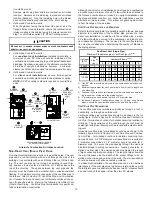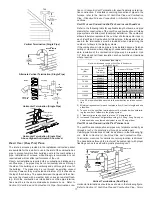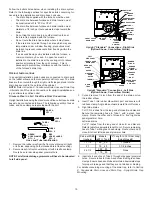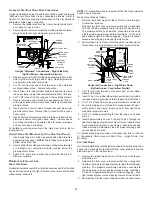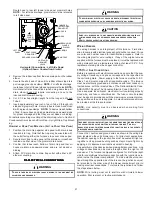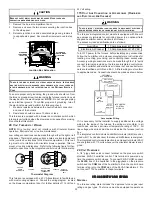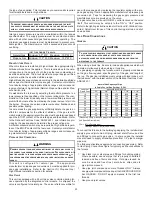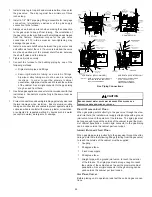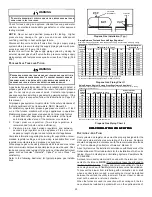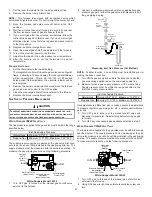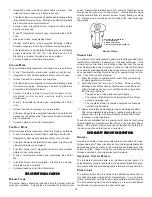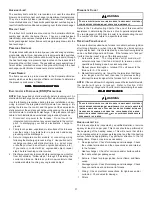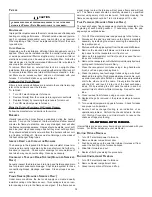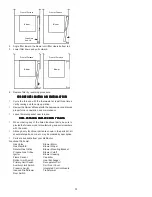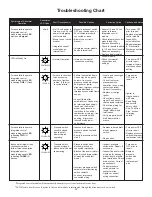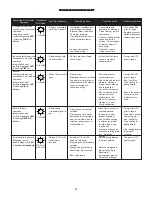
30
•
Integrated control module monitors flame presence. Gas
valve will remain open only if flame is sensed.
•
Circulator blower is energized on heat speed following a fixed
thirty second blower on delay. Electronic air cleaner terminals
are energized with circulator blower.
•
Furnace runs, integrated control module monitors safety
circuits continuously.
•
R and W thermostat contacts open, completing the call for
heat.
•
Gas valve closes, extinguishing flame.
•
Induced draft blower is de-energized following a fifteen
second post purge. Humidifier terminals are de-energized.
•
Circulator blower is de-energized following the heat off delay
period (selectable 90, 120, 150, 180; factory set at 150).
Electronic air cleaner terminals are de-energized.
•
Furnace awaits next call from thermostat.
C
OOLING
M
ODE
The normal operational sequence in cooling mode is as follows:
•
R and Y thermostat contacts close, initiating a call for cool.
•
Integrated control module performs safety circuit checks.
•
Outdoor fan and compressor are energized.
•
Circulator blower is energized on cool speed following a fixed
five second on delay. Electronic air cleaner terminals are
energized with circulator blower.
•
Furnace circulator blower and outdoor cooling unit run,
integrated control module monitors safety circuits
continuously.
•
R and Y thermostat contacts open, completing the call for
cool.
•
Outdoor fan and compressor are de-energized.
•
Circulator blower is de-energized following a fixed forty five
second cool off delay period. Electronic air cleaner terminals
are de-energized.
•
Furnace awaits next call from thermostat.
F
AN
O
NLY
M
ODE
The normal operational sequence in fan only mode is as follows:
•
R and G thermostat contacts close, initiating a call for fan.
•
Integrated control module performs safety circuit checks.
•
Circulator blower is energized on heat speed. Electronic air
cleaner terminals are energized.
•
Circulator blower runs, integrated control module monitors
safety circuits continuously.
•
R and G thermostat contacts open, completing the call for
fan.
•
Circulator blower is de-energized. Electronic air cleaner
terminals are de-energized.
•
Furnace awaits next call from thermostat.
XVI. OPERA
XVI. OPERA
XVI. OPERA
XVI. OPERA
XVI. OPERATI
TI
TI
TI
TIO
O
O
O
ONAL CHECK
NAL CHECK
NAL CHECK
NAL CHECK
NAL CHECKS
S
S
S
S
B
URNER
F
LAME
The burner flames should be inspected with the burner compart-
ment door installed. A sight glass is provided for inspection pur-
poses. Flames should stable, quiet, soft, and blue (dust may cause
orange tips but they must not be yellow). Flames should extend
directly outward from the burners without curling, floating, or lifting
off. Flames must not impinge on the sides of the heat exchanger
firing tubes.
Check the burner flames for:
1. Good adjustment
2. Stable, soft and blue
3. Not curling, floating, or lifting off.
Burner Flame
P
RIMARY
L
IMIT
The primary limit control guards against overheating resulting from
insufficient conditioned air passing over the heat exchanger. If the
primary limit control does not function during this test, the cause
must be determined and corrected. Function of this control should
be verified by gradually blocking the furnace return air after the fur-
nace has been operating (burners firing) for approximately ten min-
utes. Check the control as follows:
1.
Allow the furnace to operate with burners firing continuously
for approximately ten minutes.
2.
Gradually block the return air to furnace. Remove airflow
blockage when limit control is activated and turns off burners.
Airflow blockage causes unit overheating and will produce
the following reactions:
• The gas valve to close and extinguish flame,
• The induced draft blower to deenergized after a fifteen
second postpurge, and
• The circulator blower to remain energized continuously
until limit control resets.
3.
Remove the return air blockage to clear overheating condition.
After an acceptable temperature is reached during the cool
down period, the limit control will reset and allow the furnace
to resume normal operation.
These checks establish that the primary limit control is functioning
and will respond to a restriction in the return air, or a circulator blower
failure. If the primary limit control does not function during this test,
the cause must be determined and corrected.
XVII. SAFET
XVII. SAFET
XVII. SAFET
XVII. SAFET
XVII. SAFETY CIR
Y CIR
Y CIR
Y CIR
Y CIRCUIT DESCRIPTI
CUIT DESCRIPTI
CUIT DESCRIPTI
CUIT DESCRIPTI
CUIT DESCRIPTIO
O
O
O
ON
N
N
N
N
G
ENERAL
A number of safety circuits are employed to ensure safe and proper
furnace operation. These circuits serve to control any potential safety
hazards and serve as inputs in the monitoring and diagnosis of ab-
normal function. These circuits are continuously monitored during
furnace operation by the integrated control module.
I
NTEGRATED
C
ONTROL
M
ODULE
The integrated control module is an electronic device which, if a
potential safety concern is detected, the module will take the neces-
sary precautions and provide diagnostic information through an LED.
P
RIMARY
L
IMIT
The primary limit control is located on the partition panel and moni-
tors heat exchanger compartment temperatures. It is a normally-
closed (electrically), automatic reset, temperature-activated sensor.
The limit guards against the overheating as a result of insufficient
conditioned air passing over the heat exchanger.

